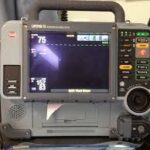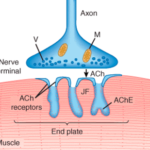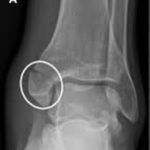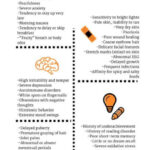What is an Infected Hangnail?
Infected Hangnail is the appearance of skin at the root of the nail that looks jagged and torn is common. This skin is called a hangnail and it is mostly seen on the fingers as opposed to the toes. Hangnails, therefore, refer to the small dry skin flaps that detach from the edges of your nail, especially during winter or after being in the water for a long time.
Although it is a common occurrence, it can lead to infection if your hand comes into contact with bacteria or other germs. When there is pain around the sides of your nail coupled with swelling or redness, you may have an infected hangnail.
An infected hangnail is also known as paronychia and depending on the severity or frequency of occurrence, it may be acute or chronic respectively.
Generally, the nail folds become inflamed due to a bacterial or fungal infection. A nail fold is the fold of hard skin where the nail and skin meet on the sides of your nail. Fungal infections of the hangnail are frequent to diabetic patients and people who spend long periods in water.
Paronychia is also similar to perionychia and loosely translated from the Greek terms; para, peri and onyx meaning next to or around the nail.
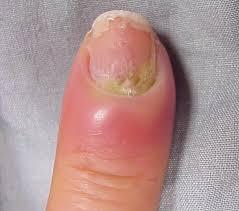
Fig: An infected hangnail swollen with fluctuance
Identification
This condition has typical symptoms that may appear suddenly if it is a bacterial infection or gradually if the infection is fungal. They include:
- Redness around the finger
- Swelling
- Tenderness or pain
- A warm feeling around the affected finger
- A blister in the affected area that has pus
- Discoloring of the nail or the infection may spread in your body if not treated promptly
When to Consult a Doctor?
- Home treatment does not improve the affected area in a week
- Blistering or pus accumulation on the affected area
- Other places of the nail show signs of being infected
- The nail separates from the skin
- Change in the affected nail’s color or shape
- You are diabetic or have other chronic immune suppressing conditions
Acute Paronychia
An infected hangnail or paronychia can be of two types: acute paronychia or chronic paronychia. Acute paronychia is a bacterial infection in which the bacteria enters through a break in the skin caused by a hangnail, persistent irritation by water and detergents or damage of the nail fold.
On the fingers, it is frequent for people who bite or suck their fingers and observed at an ingrown nail when found on the toes. New drugs in the treatment of some cancers and immune-suppressants such as those used after organ transplants can also cause acute paronychia.
Symptoms
- Acute paronychia develops at the sides and base of the nail folds along the nail margin.
- Swelling and redness: within some hours or days the affected finger develops some pain warmth redness and swelling.
- Pus accumulating under the lateral fold in the nail margin or at the base of the nail
If untreated, the infection continues penetrating: it can extend to the eponychium in which case it is called and eponychia. As the infection moves further under the nail sulcus and both lateral folds are affected, it is referred to as a runaround infection.
In rare cases, though, the infection may penetrate the finger or toe which puts the patient at risk of losing his or her finger or toe and in severe instances the whole limb. This is rare in healthy individuals but common for diabetic patients or others suffering from disorders that inhibit blood circulation.
Chronic Paronychia
This often occurs in individuals whose hands are wet all the time such as bartenders or housekeepers. When they have conditions that affect their immune system, for example, diabetes or hand eczema, it predisposes them more to the risk of frequent hangnail infections.
It is also observed that the yeast Candida has a relation to the development of chronic paronychia although eliminating it does not always stop it ultimately.
Symptoms
- The nail fold is painful and red similar to the acute form
- Pus accumulation is not common
- Loss of the cuticle that separated the nail fold from the nail plate
- Space forms allowing entry of irritants and microorganisms
- Distortion of the nail may occur eventually as the nail plates thicken, discolor, and transverse ridges form.
Diagnosis
The diagnosis is primarily inspection although skin conditions like carcinoma and herpetic whitlow have similar symptoms. As a result, clinical diagnosis is necessary and involves studying the patient’s history as well as administering the following laboratory tests
- Gram staining and culture in identifying the causative bacteria for paronychia which will help better treat the condition.
- 5% smears of potassium hydroxide to diagnose a paronychia caused by candida infection
- If herpetic whitlow is suspected, Tzanck smears are used to confirm the diagnosis. 5
How to Prevent?
Hangnails are common especially if your hands are frequently wet or if they are dry such as during the winters. However, certain habits or factors increase their appearance. For example, the frequent handling of chemicals or repetitively washing hands without moisturizing afterward. Preventing hangnail infections involve:
Preventing hangnails is the best way to avoid a hangnail infection. This can be done by moisturizing your hands with lotions and creams about three times every day. Proper manicure by certified specialists also helps maintain a healthy nail by providing a healthy nail bed and growth of cuticles.
Getting rid of hangnails also helps to prevent their infection. However, avoid tearing or biting a hangnail which will injure the nail bed or rip tissue along with hangnail. This allows bacteria or fungi to enter and cause an infection. Instead, clip the nail with sharp cuticle scissors and moisturize the area after removal.
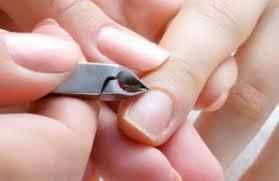
Fig: How to remove a hangnail properly
Other ways you can prevent having infected hangnails is by:
- Keeping the fingers clean and dry is also a measure to avoid hangnail infection. Immersing your hands in water regularly can cause the nails to split but having clean nails avoids undergrowth of bacteria that would cause an infection.
- Using rubber gloves if you need to expose the hands to chemicals such as those in detergents when washing dishes.
- Ensuring nail hygiene as it prevents hangnails or their infection if present. Trim your nails straight and round at the tips of the nail in a curve using sharp manicure scissors. Strengthen the nails by applying a protective coat of nail hardener when manicuring or polishing your nails.
Treatment
A hangnail infection may be treated at home by:
- Soaking the infected area in warm water twice to four times daily if the finger has swollen without fluctuance.
- Remove the hangnail to avoid further infection after the first soak by cutting it straight with sharp cuticle scissors. Treat the area with moisturizing then antibiotic cream and bandage to cover the area.
Clinicians should be involved where the infection is no longer mild. Treatments they adopt include:
- Draining a fluctuant swelling or where pus is visible by inserting a scalpel blade between the nail and nail fold. Inserting a thin gauze wick for 24 to 48 hours to allow drainage is an alternative treatment.
- Giving you an antibiotic treatment such as antistaphylococcal antibiotics based on the results of local sensitivity testing
- Monitoring development of other severe infections. In diabetic patients or those having conditions like peripheral vascular disease, toe paronychia should be monitored for cellulitis or symptoms of other severe infections. Such patients and those in an immune-compromised state should be put in a short course of diabetes to relieve the symptoms.
Reference List
- Nail hygiene. http://newsnetwork.mayoclinic.org/discussion/mayo-clinic-q-and-a-self-care-can-strengthen-weak-fingernails/
- https://www.reference.com/beauty-fashion/treatments-hangnails-67a013c3191a79d9?qo=cdpArticles
- Infected hangnails: https://www.reference.com/beauty-fashion/can-rid-hangnails-8464b73880f6901e?qo=cdpArticles
- Nail disorders. https://www.merckmanuals.com/professional/dermatologic-disorders/nail-disorders/acute-paronychia#v966843
- Paronychia. http://emedicine.medscape.com/article/1106062-overview
- Paronychia. http://www.medicinenet.com/script/main/art.asp?articlekey=16638
- http://www.medicinenet.com/script/main/art.asp?articlekey=11988
- Infected hangnail. http://www.healthline.com/health/infected-hangnail

